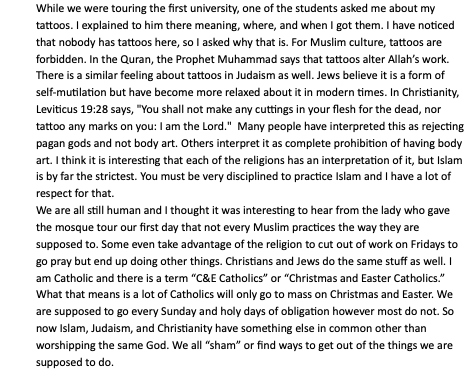Blog 2: Sociolinguistic landscape of Morocco
An aspect of the culture in Morocco I find to diverge from the culture I’ve experienced in the United States (in all regions I’ve lived) is the active engagement to break down language barriers. The state of languages prevalent in Morocco post-independence has been considered and extrapolated upon in academic work. The country’s medium of instruction (MOI) post-independence shifted to Arabization for 30 years until 2011 when Amazigh language(s) were recognized as an official language(s) in Morocco. Prior to 2011 but post-independence, this meant teaching the core subjects in Modern Standard Arabic(MSA) instead of French to reclaim cultural capital and reduce the influence of France’s previous colonial power. Moroccan Arabic (Darija) is considered the "real mother tongue" (Spolsky) of non-Amazigh speakers but has been restricted to the home whereas French and Classical Arabic are restricted to the workplace. As such, it is commonplace for Moroccans to be multilingual with "one or more languages spoken at home and additional languages or languages used in the community"(Spolsky).
For those curious, the Amazigh culture in Morocco has three identifiable languages based on region. The Tamazight language in the middle/center, Tarifit in the northern region and Tashelhit in the southern region. Tamazight is the term that is commonly used to generalize these three languages, however they have distinct characteristics. According to the article cited in this post, the Tamazight and Tashelhit dialects are mutually intelligible. If you want to learn a bit more about the nuance of regional language I would definitely skim the article because it provides historical insight and cultural context.
The Moroccan people I have encountered thus far have spoken French, Arabic, a hybrid of both, and at the very least basic, conversational English. The historical French influence has certainly shaped the varied dialects spoken across Morocco, but I have been struck by the active effort taken by many Moroccans to engage and learn languages. The language capacity of the cultures I’ve encountered in the United States has been limited largely to English. The friends that I have who do speak two languages come from multicultural homes where at least one parent speaks English as a second language. Outside of those instances, I have found multilingual speakers to be quite uncommon. I think that our culture while of a diverse makeup, does not provide the emphasis nor opportunity to learn and practice secondary languages. The state of American culture is typically very centered around the generalized American identity which is often reflected by English speakers. Another aspect of this discussion of American sociolinguistics is the need for multilingual speakers. While it is with no doubt a great advantage to speak multiple languages, the economic and cultural characteristics of the States mean that English speakers face (generally speaking) no daily pressure to communicate in other languages. English is the standard spoken language in American schools and businesses. This is to say that the majority of English speaking Americans are not denied access to opportunities due to only speaking English and even in collaboration with the international community in academia and other realms English speakers are often more so catered to than other languages. The Moroccan people do not have this luxury and have chosen to adapt their schooling to use more prominent languages used in Academia to enable their students to have access to opportunities.
References:

Comments
Post a Comment